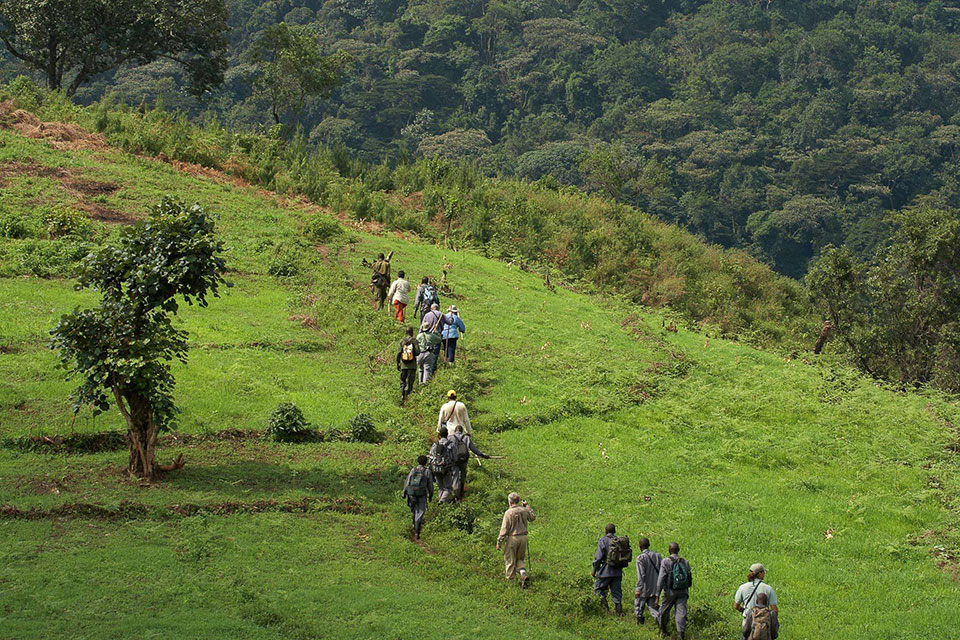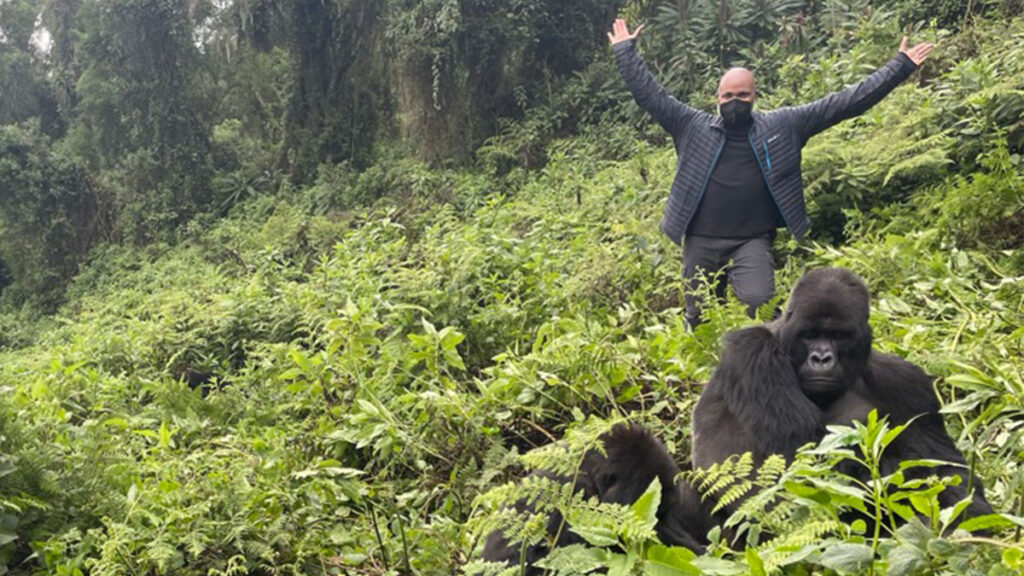
A trek to view a mountain gorilla group is a life time experience. For exceptional gorilla safaris in Africa, visit Bwindi Impenetrable Forest and Mgahinga Gorilla National Park in Southwestern Uganda; Volcanoes National Park in Northwestern Rwanda and the Virunga National Park in Eastern Democratic Republic of Congo (DRC). The 3 countries are the most sought after destinations by trekkers primarily to strike imaginations with these dramatic primates in their natural habitat. Mountain gorilla adventures in Uganda, Rwanda and DR Congo increased after Dian Fossey’s efforts to create awareness to the world about their existence in the jungles of Virunga Massifs prior her mysterious death in 1985.
Trekking to see these special apes in the wild involves hiking through the jungles at altitude of about 2500 to 3000 meters above sea level together with tour guides who direct visitors into habituated gorilla families. Most trekkers have however had varied views about this life changing adventure in Uganda, Rwanda and DR Congo. Trekkers want to first to assess which destination is easier or difficult to trek which entirely remains the biggest question. Questions of this kind usually come before or after the actual trek; how is gorilla trekking in Rwanda, Uganda and DR Congo? How fit should I be to trek mountain gorillas? Which destination is the easiest or hardest for me to trek? This is kinder intimidating but unavoidable we always asked these questions but never got any answers to address them. Others have even traveled to 2 or 3 of these destinations; made comparisons of which they have come up with their own descriptions about this thrilling adventure:-it is the hardest or it is the easiest or strenuous and yet in real sense this may not be the case. We all have our personal issues and because some people are used to hike in flat areas and not steep slope or age, health or medical issues most trekkers have had a bias mind towards this remarkable adventure.
Mountain gorilla adventures in Uganda, Rwanda and Congo can or may not take that long for you to encounter these humble apes but the challenge comes in when you are required to keep following a gorilla group and at the same time photographing. Ideally it becomes difficult for some people and we always encourage our visitors to hire one porter at the park to help in carrying the heavy luggage as well as the cameras but when time for photo taking comes you can get your camera. You do not need to overload yourself during the trek otherwise it can be difficult on your side. Gorilla groups are always assigned in the morning based on your option and level of physical fitness. You need to understand yourself and which family to choose to trek-there can be hard or relatively simple groups for you hike.

Gorilla trekking in Rwanda, Uganda and Congo is done in the wilderness and not in the zoo. This means that you have to hike through the jungles, the steep slopes to look for these impressive primates and all these require you to be physically fit and stable. Seasonality of the destination is also very important to put into consideration. Despite gorilla trekking being an all year round adventure, it is important to note that the wet season can be challenging to some trekkers to hike because the gorilla habitat tends to be slippery or muddy but safaris to view these species doesn’t stop. Several trekkers opt for the dry season which starts in the months of June to September and December to February when the ground is dry and simpler for visitors to trek.
This life time adventure also comes at a cost. And because of the high demand, you need to book for your gorilla trekking permit in advance at least six months before the actual trek in any destination of your choice. In Uganda, gorilla trekking safaris cost $600 for foreign non residents, $500 for foreign residents and shs.250000 for East African residents. For Rwanda adventures, visitors pay $1500 per tourist while in DR Congo you can trek gorillas at $400. Not all people are able to purchase gorilla permits depending on economic status.
Besides, your age also matters as it may determine how difficult the trek can be. People under 15 years are not allowed to go for gorilla trekking; you might be 95 years and assuming that you are assigned to similar gorilla family with persons of about 20 years, certainly the hiking pace will never be the same and this may require them to keep waiting for you. If you happen to be in this category, it is important that you go with persons within your age brackets. Take note of the altitude and then assess your physical fitness and age prior choosing your preferred gorilla family.Avoid following groups; understand yourself first. The fact that the trek involves hiking, we advise our clients to always do some practice to before actual trek so that they get accustomed to the altitude. By doing that, it will be easier for you to hike up and down the steep slopes in any of the destination where gorilla trekking takes place.
Mountain gorilla treks occur in the jungles and there are no open paths through the woodland or while you hike through the steep slopes. It is important for you to do some exercise before going for the actual trek. The trek can be hard or easy depending on the habituated gorilla family that will be allocated to you and trekking the Susa family means you need some physical fitness compared other gorilla families in Volcanoes National Park. For Sabyinyo family, it is the most straightforward to hike during mountain gorilla treks in Rwanda. The Kwitonda, Hirwa and group 13 are also not as demanding as the Susa gorilla family. The Amahoro Umubano family tends to be hard but not as tough as the Susa.
When it comes to gorilla trekking safaris in Uganda, these apes live in Bwindi Impenetrable Forest National Park which features thick vegetation and you may need to bend in order to hike through while searching for these magnificent wild creatures. If you are lucky enough, you can trek the Nshongi gorilla group which is a bit simpler to hike and you will spend relatively less time. Even if you are 60 years and above, still you can hike through this family. The Rushegura group also popular as the R-group, is also known as one of the simplest to hike due to its location around the Buhoma sector and its territory that are found in the same area. For the Nkuringo group, it is demanding and you need to be energetic with a bit of stamina to trek through to view its members.
In conclusion, gorilla trekking in Uganda, Rwanda and Democratic Republic of Congo is either difficult or easy depending on the habituated gorilla group that is assigned to you and location of its members in the habitat. Viewing these fascinating primates also comes in 2 different stages. First, the hike that begins closely at the park boundary and it takes about half or an hour depending on your speed and the family you will be tracking. The second is a trek through the forest to look for the mountain gorillas but usually trackers are sent to ascertain their location before the next trekkers get into the jungle. The first part of the trek is predictable but the second one is hard to predict as it all depends on the location of these creatures, nature of the terrain, density of the vegetation and if it rained that the habitat can be muddy and visitors find it difficult to track mountain gorillas.
